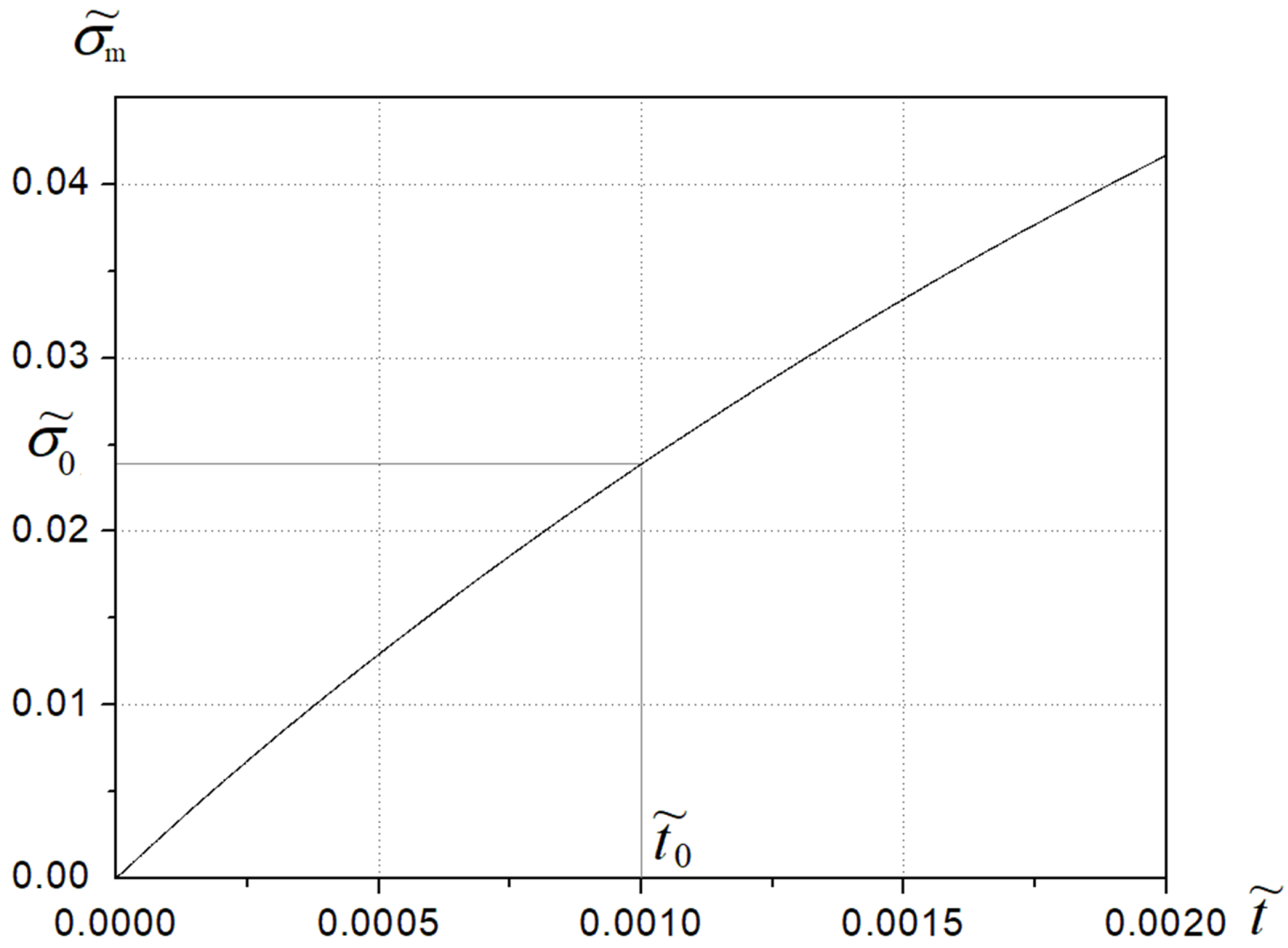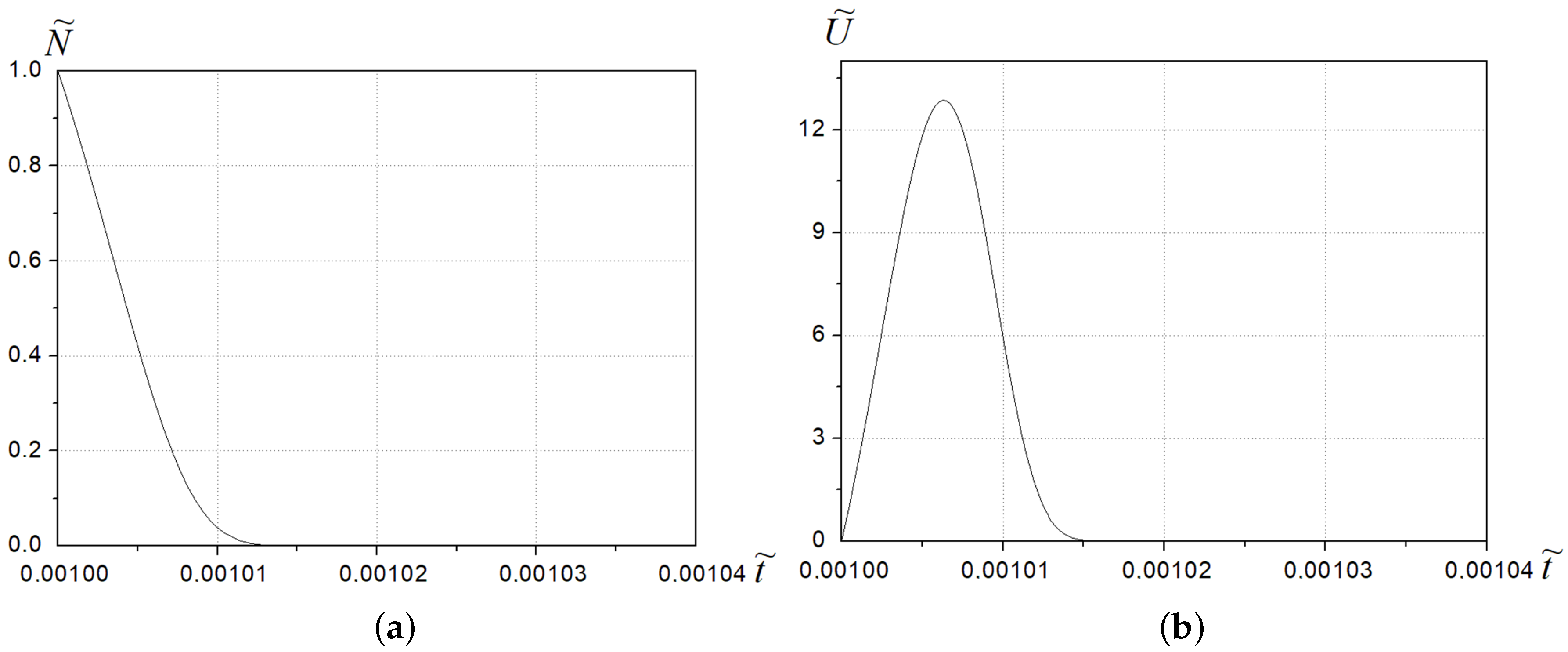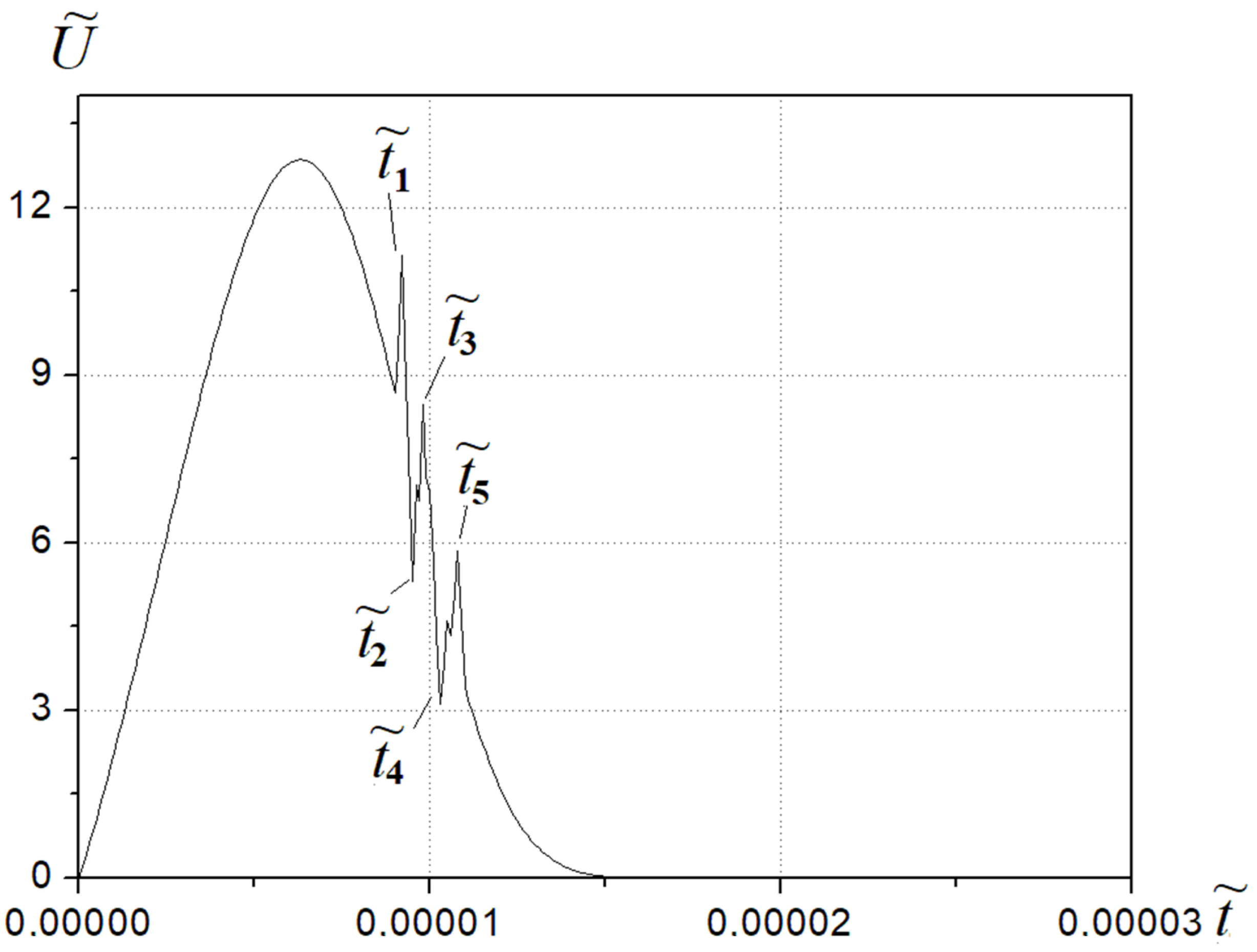Acoustic Emission during Non-Uniform Progression of Processes in Composite Failure According to the Von Mises Criterion
Abstract
:1. Introduction
2. Analysis
2.1. Simulation Conditions
2.2. Simulation Results
3. Discussion of Research Results
4. Conclusions
Author Contributions
Funding
Institutional Review Board Statement
Data Availability Statement
Conflicts of Interest
References
- Toor, Z.S. Space Applications of Composite Materials. J. Space Technol. 2018, 8, 65–70. [Google Scholar]
- Gunale, R.B.; Joshi, S. Applications of composite material in various fields. J. Emerg. Technol. Innov. Res. 2019, 6, 528–540. [Google Scholar]
- Alam, M.I.; Maraz, K.M.; Khan, R.A. A review on the application of high-performance fiber-reinforced polymer composite materials. GSC Adv. Res. Rev. 2022, 10, 20–36. [Google Scholar] [CrossRef]
- Cheng, L.; Karbhari, V.M. New bridge systems using FRP composites and concrete: A state-of-the-art review. Prog. Struct. Eng. Mater. 2006, 8, 143–154. [Google Scholar] [CrossRef]
- Blaga, L.A. Innovating Materials in Bridge Construction; Contribution to Construction with Composite Fiber-Reinforced Materials; EdituraPolitehnica: Timişoara, Romania, 2012. [Google Scholar]
- Jones, F.R. Mechanical Properties of Composite Materials. In Composites Science, Technology, and Engineering; Cambridge University Press: Cambridge, UK, 2022; pp. 160–209. [Google Scholar]
- Karnoub, A.; Huang, H.; Antypas, I. Mechanical properties of composite material laminates reinforced by woven and non-woven glass fibers. In Proceedings of the XIII International Scientific and Practical Conference “State and Prospects for the Development of Agribusiness—INTERAGROMASH 2020”, E3S Web of Conferences, Rostovon-Don, Russia, 29 June 2020. Abstract Number 12005. [Google Scholar]
- Bafekrpour, E. Advanced Composite Materials: Properties and Applications; De Gruyter Open Poland: Warsaw, Poland, 2017. [Google Scholar]
- Singh, T.; Sehgal, S. Structural health monitoring of composite materials. Arch. Comput. Methods Eng. 2022, 29, 1997–2017. [Google Scholar] [CrossRef]
- Metaxa, S.; Kalkanis, K.; Psomopoulos, C.S.; Kaminaris, S.D.; Ioannidis, G. A review of structural health monitoring methods for composite materials. Procedia Struct. Integr. 2019, 22, 369–375. [Google Scholar] [CrossRef]
- Chaki, S.; Krawczak, P. Non-Destructive Health Monitoring of Structural PolymerComposites: Trends and Perspectives in the Digital Era. Materials 2022, 15, 7838. [Google Scholar] [CrossRef] [PubMed]
- Kong, K.; Dyer, K.; Payne, C.; Hamerton, I.; Weaver, P.M. Progress and Trends in Damage Detection Methods, Maintenance, and Data-driven Monitoring of Wind Turbine Blades—A Review. Renew. Energy Focus 2023, 44, 390–412. [Google Scholar] [CrossRef]
- Liu, P. Damage Modeling of Composite Structures: Strength, Fracture, and Finite Element Analysis; Elsevier: Amsterdam, The Netherlands, 2021. [Google Scholar]
- Kurumatani, M.; Kato, T.; Sasaki, H. Damage model for simulating cohesive fracture behavior of multi-phase composite materials. Adv. Model. Simul. Eng. Sci. 2023, 10, 2. [Google Scholar] [CrossRef]
- Millen, S.L.; Lee, J. Microscale Modelling of Lightning Damage in Fibre-Reinforced Composites. J. Compos. Mater. 2023, 57, 1769–1789. [Google Scholar] [CrossRef]
- Korzec, I.; Samborski, S.; Łusiak, T. A Study on Mechanical Strength and Failure of Fabric Reinforced Polymer Composites. Adv. Sci. Technol. Res. 2022, 16, 120–130. [Google Scholar] [CrossRef]
- Bolcu, D.; Stănescu, M.M.; Miriţoiu, C.M. Some Mechanical Properties of Composite Materials with Chopped Wheat Straw Reinforcer and Hybrid Matrix. Polymers 2022, 14, 3175. [Google Scholar] [CrossRef] [PubMed]
- Ba, Y.; Sun, S. Tensile and Fatigue Properties of Fiber-Reinforced Metal Matrix Composites Cf/5056Al. Compos. Adv. Mater. 2021, 30, 2633366X20929712. [Google Scholar] [CrossRef]
- Gholizadeh, S. Damage Analysis and Prediction in Glass Fiber Reinforced Polyester Composite Using Acoustic Emission and Machine Learning. J. Robot. Autom. Res. 2022, 3, 131–141. [Google Scholar]
- Almeida, R.S.M.; Magalhães, M.D.; Karim, M.N.; Tushtev, K.; Rezwan, K. Identifying Damage Mechanisms of Composites by Acoustic Emission and Supervised Machine Learning. Mater. Des. 2023, 227, 111745. [Google Scholar] [CrossRef]
- Panasiuk, K.; Dudzik, K. Determining the Stages of Deformation and Destruction of Composite Materials in a Static Tensile Test by Acoustic Emission. Materials 2022, 15, 313. [Google Scholar] [CrossRef]
- James, R.; Joseph, R.P.; Giurgiutiu, V. Impact Damage Ascertainment in Composite Plates Using In-Situ Acoustic Emission Signal Signature Identification. J. Compos. Sci. 2021, 5, 79. [Google Scholar] [CrossRef]
- Gao, Y.; Xiao, D. Simulation and Feature Analysis of Modal Acoustic Emission Wave in Planar C/SiC Composite. Int. J. Vibroeng. 2018, 20, 748–761. [Google Scholar] [CrossRef]
- Gemmeren, V.; Graf, T.; Dual, J. Modeling the Acoustic Emissions Generated during Dynamic Fracture Under Bending. Int. J. Solids Struct. 2020, 203, 84–91. [Google Scholar] [CrossRef]
- Hamam, Z.; Godin, N.; Fusco, C.; Doitrand, A.; Monnier, T. Acoustic Emission Signal Due to Fiber Break and Fiber Matrix Debonding in Model Composite: A Computational Study. Appl. Sci. 2021, 11, 8406. [Google Scholar] [CrossRef]
- Dzepina, B.; Balinta, D.; Dini, D. A Phase Field Model of Pressure-Assisted Sintering. J. Eur. Ceram. Soc. 2019, 39, 173–182. [Google Scholar] [CrossRef]
- Heinrich, C.; Waas, A.M. Investigation of Progressive Damage and Fracture in Laminated Composites Using the Smeared Crack Approach. In Proceedings of the 53rd AIAA/ASME/ASCE/AHS/ASC Structures, Structural Dynamics and Materials Conference, Honolulu, HI, USA, 23–26 April 2012; p. 1537. [Google Scholar]
- Jin, W.; Arson, C. Micromechanics Based Discrete Damage Model with Multiple Non-Smooth Yield Surfaces: Theoretical Formulation, Numerical Implementation and Engineering Applications. Int. J. Damage Mech. 2018, 27, 611–639. [Google Scholar] [CrossRef]
- Turcotte, D.L.; Newman, W.I.; Shcherbakov, R. Micro and Macroscopic Models of Rock Fracture. Geophys. J. Int. 2003, 152, 718–728. [Google Scholar] [CrossRef]
- Swolfs, Y.; McMeeking, R.M.; Rajan, V.P.; Zok, F.W.; Verpoest, I.; Gorbatikh, L. Global Load-Sharing Model for Unidirectional Hybrid Fibre-Reinforced Composites. J. Mech. Phys. Solids 2015, 84, 380–394. [Google Scholar] [CrossRef]
- Kun, F.; Hidalgo, R.C.; Raischel, F.; Herrmann, H.J. Extension of Fibre Bundle Models for Creep Rupture and Interface Failure. Int. J. Fract. 2006, 140, 255–265. [Google Scholar] [CrossRef]
- Raischel, F.; Kun, F.; Herrmann, H.J. A Simple Beam Model for the Shear Failure of Interfaces. Phys. Rev. E 2005, 72, 046126. [Google Scholar] [CrossRef] [PubMed]
- Kovács, K.; Hidalgo, R.C.; Pagonabarraga, I.; Kun, F. Brittle-to-Ductile Transition in a Fiber Bundle with Strong Heterogeneity. Phys. Rev. E 2013, 87, 042816. [Google Scholar] [CrossRef] [PubMed]
- Pradhan, S.; Kjellstadli, J.T.; Hansen, A. Variation of Elastic Energy Shows Reliable Signal of Upcoming Catastrophic Failure. Front. Phys. 2019, 7, 106. [Google Scholar] [CrossRef]
- Danku, Z.; Ódor, G.; Kun, F. Avalanche Dynamics in Higher-Dimensional Fiber Bundle Models. Phys. Rev. E 2018, 98, 042126. [Google Scholar] [CrossRef]
- Tanasehte, M.; Hader, A.; Sbiaai, H.; Achik, I.; Boughaleb, Y. The Effect of Fibers-Matrix Interaction on the Composite Materials Elongation. In Proceedings of the IOP Conference Series: Materials Science and Engineering, International Conference on Advances in Energy Technologies, Environment, El Jadida, Morocco, 13–14 December 2018; p. 012032. [Google Scholar]
- Chakrabarti, B.K.; Biswas, S.; Pradhan, S. Cooperative Dynamics in the Fiber Bundle Model. Front. Phys. 2021, 8, 613392. [Google Scholar] [CrossRef]
- Shcherbakov, R. On Modeling of Geophysical Problems. Ph.D. Thesis, Cornell University, Ithaca, NY, USA, 2002. [Google Scholar]
- Filonenko, S.; Kalita, V.; Kosmach, A. Destruction of Composite Material by Shear Load and Formation of Acoustic Radiation. Aviation 2012, 16, 5–13. [Google Scholar] [CrossRef]
- Filonenko, S.; Stadychenko, V. Influence of Loading Speed on Acoustic Emission During Destruction of a Composite by Von Mises Criterion. Am. J. Mech. Mater. Eng. 2020, 4, 54–59. [Google Scholar] [CrossRef]
- Filonenko, S.; Stakhova, A. Amplitude-Energy Parameters of Acoustic Radiation with Composite Properties Changing and Mises Destruction. J. Autom. Mob. Robot. Intell. Syst. 2022, 16, 19–24. [Google Scholar]
- Guo, F.; Li, W.; Jiang, P.; Chen, F.; Liu, Y. Deep Learning Approach for Damage Classification Based on Acoustic Emission Data in Composite Materials. Materials 2022, 15, 4270. [Google Scholar] [CrossRef]
- Roundi, W.; Mahi, A.E.; Rebiere, J.L.; Gharad, A.E. Monitoring Damage Evolution with Acoustic Emission in Two Types of Glass Epoxy Laminates. Polym. Polym. Compos. 2022, 30, 09673911221109906. [Google Scholar] [CrossRef]





Disclaimer/Publisher’s Note: The statements, opinions and data contained in all publications are solely those of the individual author(s) and contributor(s) and not of MDPI and/or the editor(s). MDPI and/or the editor(s) disclaim responsibility for any injury to people or property resulting from any ideas, methods, instructions or products referred to in the content. |
© 2024 by the authors. Licensee MDPI, Basel, Switzerland. This article is an open access article distributed under the terms and conditions of the Creative Commons Attribution (CC BY) license (https://creativecommons.org/licenses/by/4.0/).
Share and Cite
Filonenko, S.; Stakhova, A.; Bekö, A.; Grmanova, A. Acoustic Emission during Non-Uniform Progression of Processes in Composite Failure According to the Von Mises Criterion. J. Compos. Sci. 2024, 8, 235. https://doi.org/10.3390/jcs8070235
Filonenko S, Stakhova A, Bekö A, Grmanova A. Acoustic Emission during Non-Uniform Progression of Processes in Composite Failure According to the Von Mises Criterion. Journal of Composites Science. 2024; 8(7):235. https://doi.org/10.3390/jcs8070235
Chicago/Turabian StyleFilonenko, Sergii, Anzhelika Stakhova, Adrián Bekö, and Alzbeta Grmanova. 2024. "Acoustic Emission during Non-Uniform Progression of Processes in Composite Failure According to the Von Mises Criterion" Journal of Composites Science 8, no. 7: 235. https://doi.org/10.3390/jcs8070235





